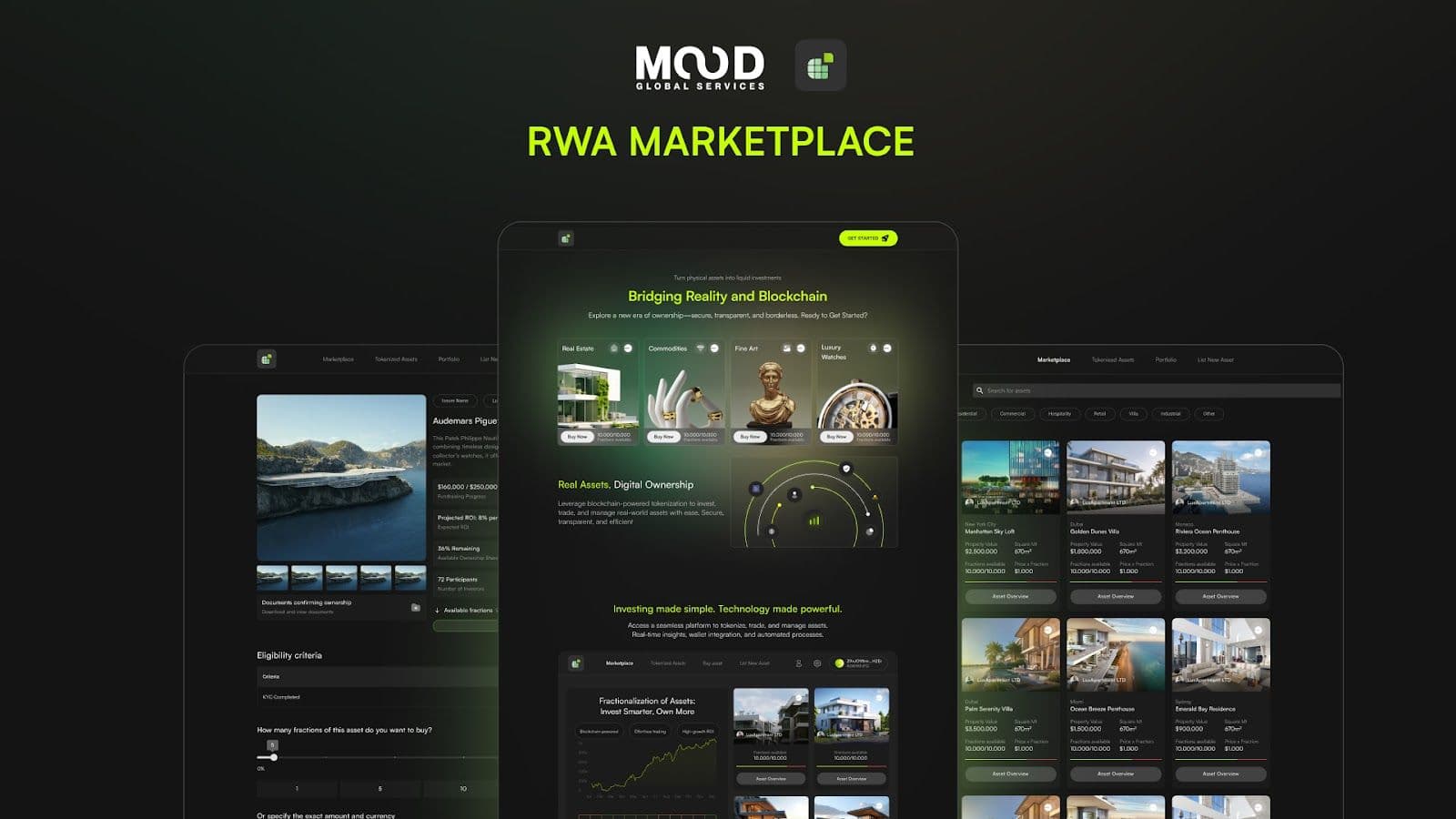Introduction
Web 3.0 is often associated with abstract and complex technological constructs. This presents a challenge for designers: to create a visual language that interprets and communicates these concepts clearly. Geometric shapes, futuristic colors, and high-level visual metaphors are commonly used to define a new kind of user interaction in digital products.
Considering these unique design challenges, the project required the development of both a dedicated landing page and a comprehensive web platform to address diverse user needs and clearly communicate the platform's value proposition. The landing page was designed to provide users with a concise overview of the platform’s functionality and mission, serving as the first point of contact before they begin using the application.
 Designing the dashboard: grand-overview
Designing the dashboard: grand-overview
Let’s dive into the design process and explore how we brought this ecosystem to life.
Project Overview
RWA Marketplace is a web-based platform designed for buying, selling, and sharing tokenized real-world assets. These include real estate, luxury goods, and art. The platform allows users to purchase or trade fractional ownership in these assets, making investment opportunities more accessible.
The main goal of the platform is to simplify interaction with tokenized assets for both newcomers and experienced users. An intuitive interface ensures seamless onboarding, investment, and asset management—even for those without in-depth Web3 knowledge.
The platform is designed for multiple user types:
- Retail investors seeking accessible investment opportunities
- Asset owners and businesses aiming to tokenize assets and raise capital
- Institutional investors looking to diversify their portfolios through fractional ownership
- Non-technical users wanting a secure and efficient way to invest in digital assets
 Mobile frendly webshop style cards
Mobile frendly webshop style cardsDesign Goals & Process
Before beginning the design phase, several key objectives were identified:
- Create an intuitive dual-purpose interface that works for both professionals and newcomers in the tokenization space.
- Ensure a transparent, informative, and efficient buy/sell experience.
- Integrate regulatory compliance through KYC/KYB verification using Sumsub.
- Support various asset types and user roles, laying the foundation for scalability.
- Apply best practices from Web3 and fintech to align with industry standards.
The main UX challenge was to present enough clear information for users to make confident investment decisions without overwhelming them. Asset cards were designed to maximize transparency, including ownership documents and investment metrics.
Let’s explore how UX design influences decision-making in asset acquisition and why displaying the right information in the right place truly matters:
This asset card is a clear example of how visual hierarchy and smart content grouping help users instantly assess an opportunity.
Color indicators at the bottom hint at funding progress, while the Asset Overview CTA guides the user to detailed metrics. Every element here was designed to eliminate friction and build trust — even for first-time Web3 users.
 Card key features
Card key features
Let’s explore the Asset Screen and the key information it provides to support confident decision-making.
This screen is designed to give users a comprehensive view of a tokenized asset — combining visuals, legal documentation, fundraising data, and investment options in one place.
Key Benefits:
- Clear visual presentation of the asset with supporting images
- Trust-building transparency through ownership documents and KYC status
- Real-time fundraising metrics for informed decisions
- Flexible investment input with the option to choose fraction amounts via slider or by entering an exact value and currency manually.
- The Subtotal section updates instantly as users input amounts or select fractions, providing immediate clarity on costs, fees, and payment breakdown.
The asset card and purchase page are essential components of the investment experience. The asset card offers a quick, visually engaging overview that helps users identify attractive opportunities at a glance. Meanwhile, the purchase page delivers all critical details in one place — from ownership documentation to real-time pricing — ensuring transparency and trust.
Together, these interfaces streamline the user journey and empower investors to make informed decisions with confidence.
UI Framework & Design Techniques
The interface was built using the MUI (Material UI) component library, which allowed for faster implementation with ready-to-use, customizable UI elements.
The design followed these core principles:
- Clarity and Minimalism – Clean layout, logical hierarchy, and focus on primary actions for improved comprehension.
- Modularity – Reusable components (e.g., asset cards, filters, forms) enable easier updates and feature expansion.
- Data Visualization – Real-time metrics, funding progress, and ownership stats enhance trust and decision-making.
- Context Preservation – Key interactions occur in modal windows to maintain page context.
- Responsiveness and Accessibility – Adaptive design for all screen sizes, with light/dark mode, currency, and language selection to support a global user base.
 Core design priniciples; including minimalism and darkmode
Core design priniciples; including minimalism and darkmode Key Functionality
The platform includes the following features:
- Authentication with Sumsub integration
- New asset listing flow
- Business dashboard with analytics
- Profile and settings pages
- Marketplace with full buy/sell functionality
- Fraction selection and price setting
- Offer system with send/receive capabilities
- Finalized sale and ownership transfer process
Together, these features form a comprehensive and secure tokenized asset trading experience.
 Key functionalities
Key functionalitiesScalability & Future Growth
RWA Marketplace is designed to scale. The architecture supports:
- Expansion of Asset Classes – Easily accommodates commodities, collectibles, financial instruments, and more.
- DeFi Integrations – Potential for staking, liquidity pooling, and decentralized borrowing.
- Modular UI Growth – Built using reusable MUI components for smooth feature rollout.
- Dynamic Marketplace Filtering – Flexible filtering system that scales with growing categories and user preferences.
Thanks to these architectural decisions, the platform can easily adapt to the evolving Web3 ecosystem and support a wider range of users and assets.
Conclusion
RWA Marketplace combines regulatory compliance, accessible UX, and native Web3 functionality to deliver a scalable platform for tokenized asset investment. With thoughtful UI/UX design and a modular development approach, it offers a secure and intuitive environment where users of any experience level can participate in the growing world of real-world asset tokenization.

